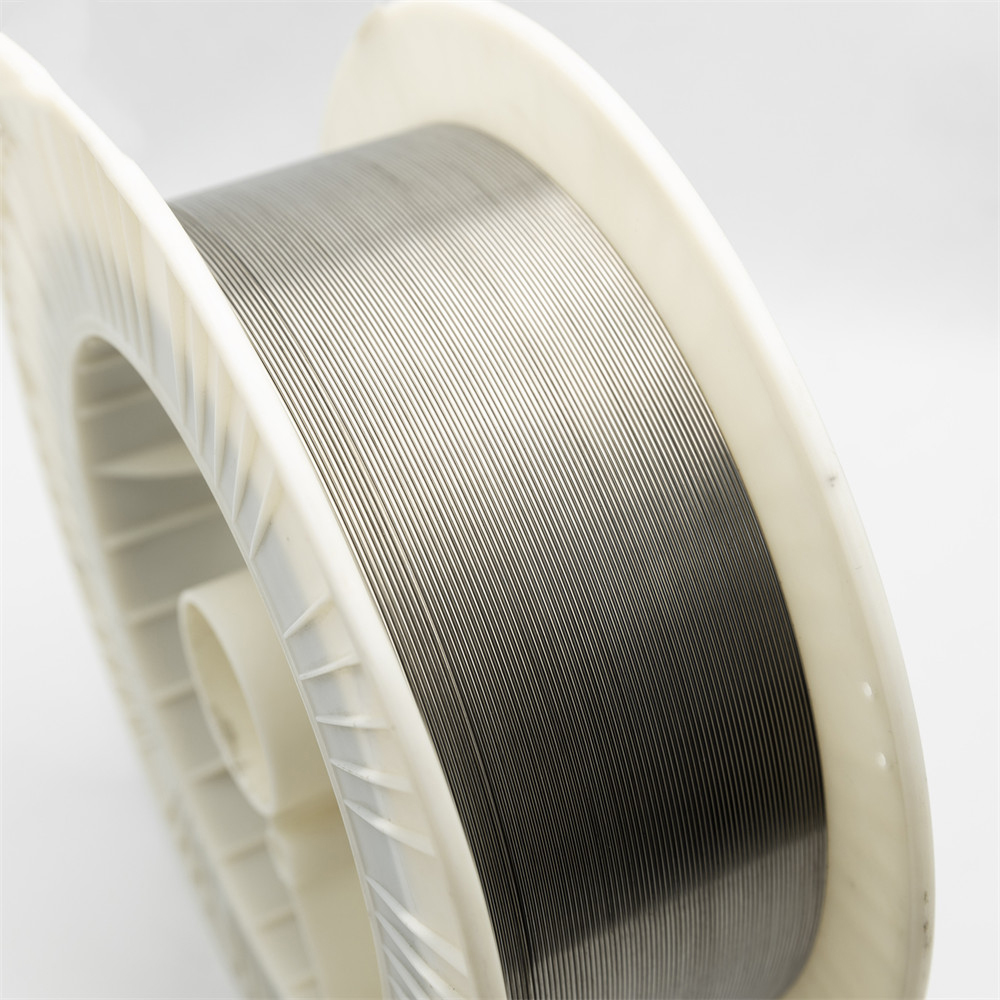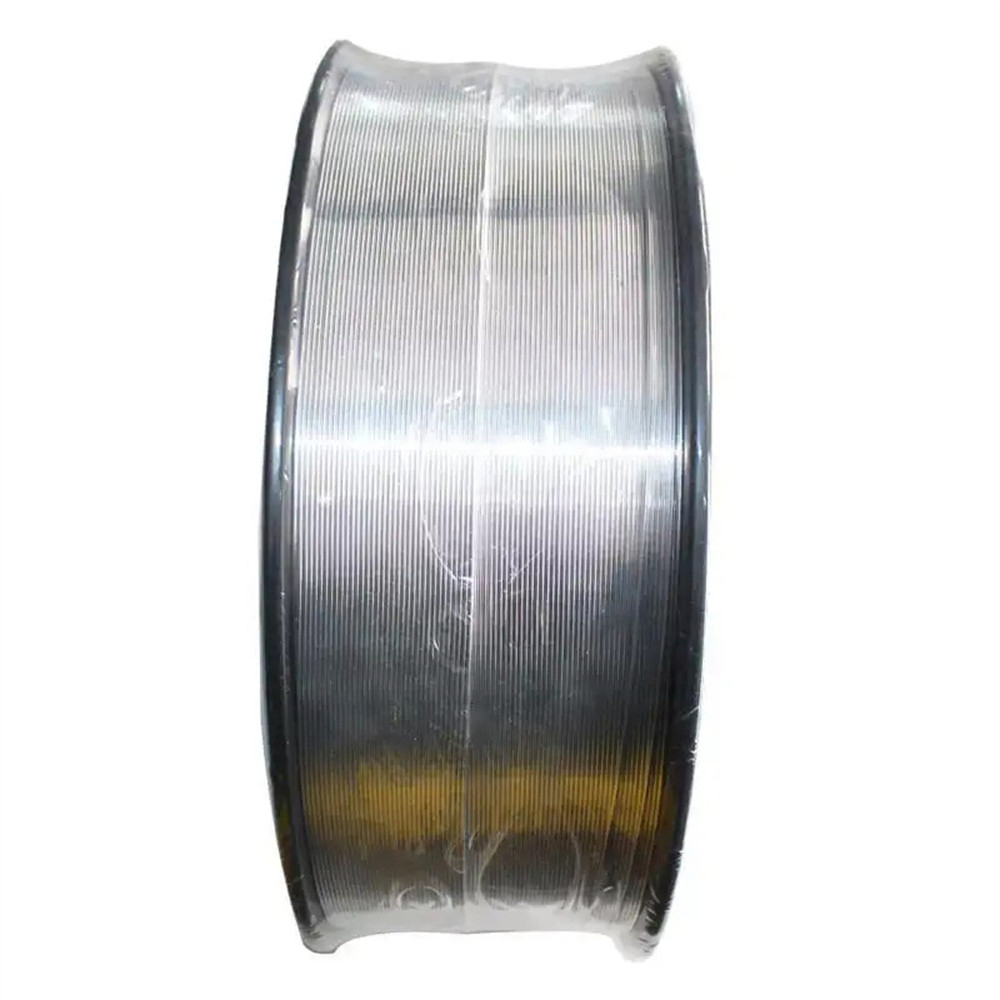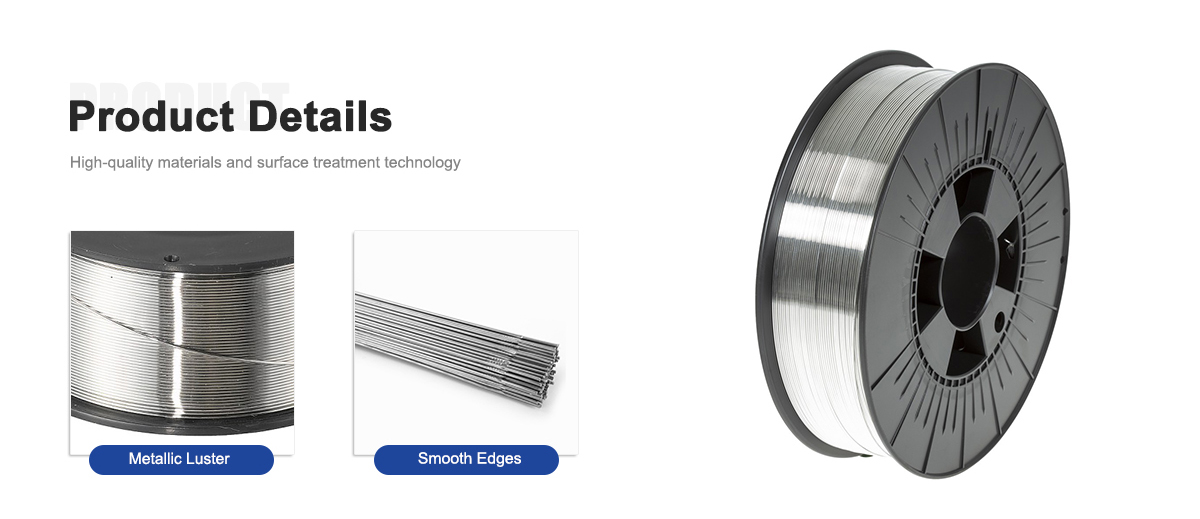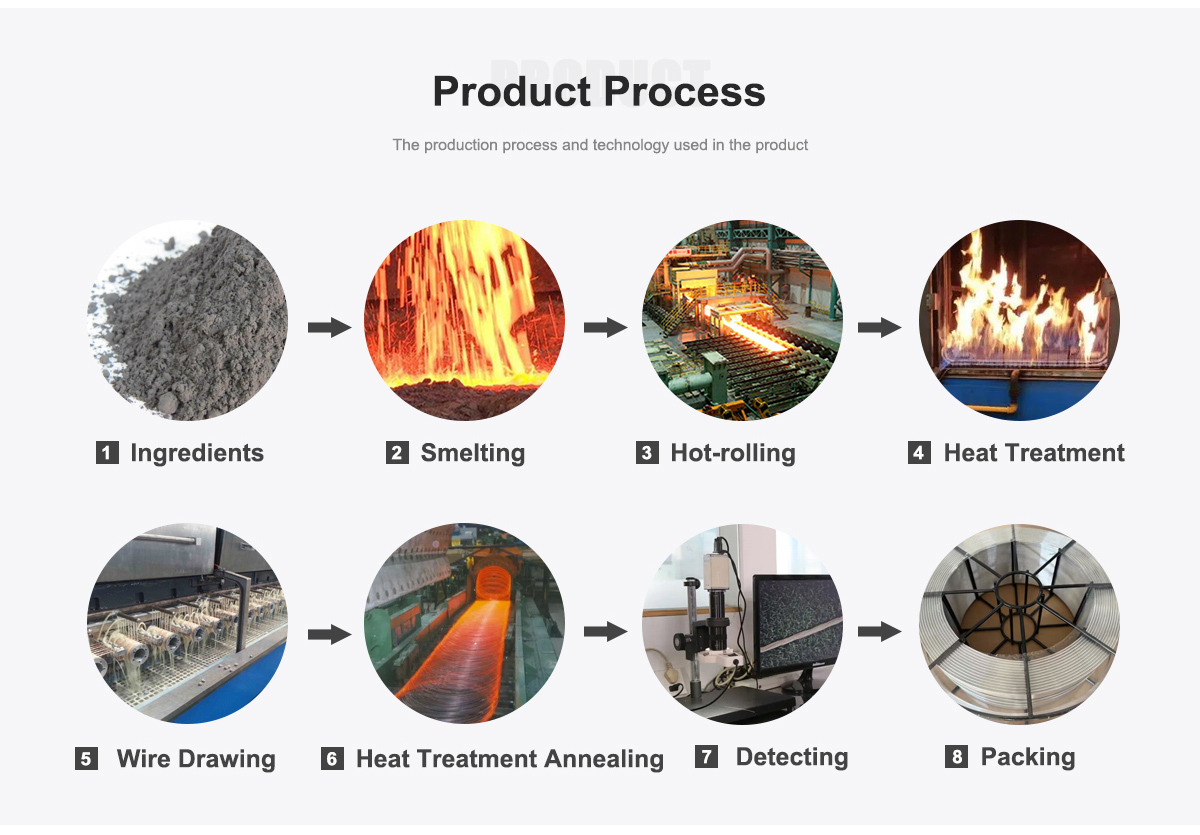 0
0
Products Description

Nickel-based welding wire has important applications in welding nuclear power plant equipment. As a key equipment in the special environment of a nuclear power plant, the selection of welding processes and materials is crucial to ensuring the safety and reliability of the equipment.
Nickel-based welding wires offer several advantages in welding nuclear power plant equipment. First of all, nickel-based welding wire has excellent corrosion resistance and can resist corrosive media present in nuclear power plants, such as acid and alkali solutions, high-temperature water vapor, etc. This corrosion resistance can effectively extend the service life of equipment and reduce the frequency of repairs and replacements.
Secondly, nickel-based welding wire has excellent high-temperature strength and thermal stability. Nuclear power plant equipment will be affected by high temperatures and thermal cycles during operation, and nickel-based welding wire can maintain high strength and stability in high-temperature environments and is not prone to deformation and cracks, ensuring the reliability and sealing of welded joints.
In addition, nickel-based welding wire can adapt to thermal expansion and contraction caused by temperature changes in nuclear power plant equipment. It has good thermal expansion properties and can effectively absorb thermal stress and reduce stress concentration on welded joints and equipment structures, thereby reducing the risk of damage and fracture caused by thermal fatigue.
When welding nuclear power plant equipment, it is very important to select the appropriate nickel-based wire material and welding process. Factors such as the working conditions of the equipment, the requirements of the welded joints, and the compatibility of materials need to be considered to ensure the quality of the welding and the reliability of the joints. In addition, strict quality control and welding monitoring are also key measures to ensure welding quality.

Welding series:
ERNiCrMo-3,ERNiCrMo-4,ERNiCrMo-13,ERNiCrFe-3,ERNiCrFe-7,ERNiCr-3,ERNiCr-7,ERNiCu-7,ERNi-1, ER70S-6.
Standard: Conforms to Certification AWS A5.14 ASME SFA A5.14
Size: 0.8MM / 1.0MM / 1.2MM / 1.6MM / 2.4MM / 3.2MM / 3.8MM / 4.0MM / 5.0MM
Form: MIG(15kgs/spool), TIG(5kgs/box),Strip
Parameter:

Main component: nickel alloy (nickel is the main component, including other alloy elements)
Diameter range: usually between 0.8mm and 2.4mm
Strength: High strength and excellent mechanical properties
Corrosion resistance: Ability to resist erosion by corrosive media and chemicals in the nuclear power plant environment
High temperature resistance: able to withstand stress and thermal cycles in high temperature working environments
Item | ERNiCrMo-3 | ERNiCrMo-4 | ERNiCrMo-13 | ERNiCrFe-7 | ERNiCr-3 | ERNiCu-7 | ERCuNi | ERNi-1 |
C | 0.1 | 0.02 | 0.01 | 0.04 | 0.1 | 0.15 | 0.03 | 0.15 |
Mn | 0.05 | 1 | 0.5 | 1 | 2.5-3.5 | 4 | 0.5-1.0 | 1 |
Fe | 5 | 4-7 | 1.5 | 7-11 | 3 | 2.5 | 0.65 | 1 |
P | 0.02 | 0.04 | 0.015 | 0.02 | 0.03 | 0.02 | 0.01 | 0.03 |
S | 0.015 | 0.03 | 0.005 | 0.015 | 0.015 | 0.015 | 0.01 | 0.015 |
Si | 0.05 | 0.08 | 0.1 | 0.5 | 0.5 | 1.25 | 0.15 | 0.75 |
Cu | 0.5 | 0.5 | N/A | 0.3 | 0.5 | rest | rest | 0.25 |
Ni | ≥58 | rest | rest | rest | ≥67 | 62-69 | 30-32 | ≥93 |
Co | N/A | 2.5 | 0.3 | N/A | N/A | N/A | N/A | N/A |
Al | 0.4 | N/A | 0.1-0.4 | 1.1 | N/A | 1.25 | 0.15 | 1.5 |
Ti | 0.4 | N/A | N/A | 1 | 0.75 | 1.5-3 | 0.5 | 2-3.5 |
Cr | 20-23 | 14.5-16.5 | 22-24 | 28.5-31 | 18.0-22.0 | N/A | N/A | N/A |
Nb+Ta | 3.5-4.15 | N/A | 1.8-2.5 | 0.01 | 2.0-3.0 | N/A | N/A | N/A |
Mo | 8.0-10 | 15-17 | 15-16 | 0.5 | N/A | N/A | N/A | N/A |
V | N/A | 0.35 | N/A | N/A | N/A | N/A | N/A | N/A |
W | N/A | 3.0-4.5 | N/A | N/A | N/A | N/A | N/A | N/A |
Rest | ≤0.50 | ≤0.50 | ≤0.50 | ≤0.50 | ≤0.50 | ≤0.50 | ≤0.50 | ≤0.50 |

Nickel and Nickel Alloy Welding Wire | |
Product Model (AWS) | Application |
ERNiCr-3 | For welding 600, 601 and 800 alloys themselves, and welding dissimilar steels between stainless steel and carbon steel ERNiCrFe-7; For welding Inconel alloys within ASTM B163, 166, 167 and 168 |
ERNiCrFe-6 | For welding of steel and Inconel, welding of steel and stainless steel and nickel-based alloys |
ERNiCrCoMo-1 | Dissimilar welding for welding nickel-chromium-cobalt-molybdenum alloys and various superalloys |
ERNiCrMo-3 | It is used for welding of nickel alloy, carbon steel, stainless steel and low alloy steel, mainly used for welding of 625, 601, 802 alloy and welding of 9% nickel alloy |
ERNi-CI | Industrial pure nickel for welding malleable and grey cast iron |
ERCuNi | For welding of 70/30, 80/20, 90/10 copper-nickel alloys |
ERNiCu-7 | For welding nickel copper alloys B127, 163, 164 and 165 etc. |
ERNi-1 | For welding of pure nickel castings and forgings such as alloys within ASTM B160, 161, 162, 163 |
ERNiFeMn-CI | For welding of nodular cast iron, ductile iron, malleable cast iron and grey cast iron to itself or to stainless steel, carbon steel, low alloy steel and various nickel alloys |
ERNiCrMo-4 | For welding nickel-chromium-molybdenum alloy itself, or welding nickel-chromium-molybdenum alloy and steel and most other nickel-based alloys |
ERNiCrMo-11 | It is used for welding of nickel-chromium-molybdenum alloy itself, or welding of nickel-chromium-molybdenum alloy and steel and most other nickel-based alloys, and can also be used for surfacing welding of nickel-chromium-molybdenum alloy and steel welding seam |
ERNiCrMo-13 | For welding low carbon nickel chromium molybdenum alloys |

Product Features:

Corrosion resistance: Nickel-based welding wire has excellent corrosion resistance and can resist the erosion of corrosive media and chemicals in the nuclear power plant environment, thereby ensuring the durability and reliability of the welded joints.
High temperature resistance: Nickel-based welding wire can maintain stability and strength in high-temperature working environments and is not prone to deformation, melting or oxidation, ensuring that the welded joint can withstand the working conditions of nuclear power plant equipment.
High strength: Nickel-based welding wire has high strength and excellent mechanical properties. The welding joint can withstand the working load and pressure of nuclear power plant equipment, ensuring the structural strength and integrity of the equipment.
Excellent welding performance: Nickel-based welding wire has good welding performance and can be welded well with materials commonly used in nuclear power plant equipment, such as stainless steel, alloy steel, etc., ensuring the quality and reliability of welded joints.
Specific applications:

Nickel-based welding wire has a wide range of applications in welding nuclear power plant equipment, including but not limited to the following:
Manufacturing and repair of nuclear reactor equipment
Connection and repair of nuclear power plant equipment pipelines
Welding and repair of structural parts of nuclear power plant equipment
Other relevant knowledge points:

Welding nuclear power plant equipment requires strict compliance with relevant quality standards and safety regulations to ensure the quality and reliability of welded joints.
The quality inspection of nickel-based welding wire is particularly important in welding nuclear power plant equipment, including composition analysis, metallographic structure analysis, mechanical property testing, corrosion resistance testing, etc.
In summary, nickel-based welding wire, as an important welding material for welding nuclear power plant equipment, has excellent corrosion resistance, high temperature resistance and high strength properties. Its corrosion resistance, high temperature resistance, high strength and excellent welding properties make it an ideal choice for welding nuclear power plant equipment. By using nickel-based welding wire, the integrity and reliability of nuclear power plant equipment can be ensured and the safety and reliability of nuclear power plants can be improved.
Production Process:

The production process of nickel-based welding wire usually includes the following main steps:
Raw material preparation: Select high-purity nickel alloy as the main raw material. Depending on the specific requirements of the welding wire, other alloying elements and additives may be added.
Material pretreatment: Pretreatment of raw materials, including steps such as cleaning, grinding and screening, to remove impurities and ensure the uniformity of the material.
Smelting and alloying: Put the pretreated raw materials into a high-temperature smelting furnace for smelting and alloying. By heating and controlling the amount of alloying elements added, ensure that the alloy composition reaches the required ratio.
Continuous casting or hot rolling: Pour the melted alloy liquid into a continuous casting machine or perform hot rolling to form continuous bars or strips.
Steel wire drawing: The continuously cast bar or hot-rolled strip is subjected to a series of steel wire drawing processes to gradually reduce the diameter to form a welding wire of the required diameter.
Welding wire surface treatment: Surface treatment of the welding wire, including degreasing, pickling and polishing, to remove surface oxides and impurities and improve the surface quality of the welding wire.
Welding wire packaging and storage: Welding wire is packaged. Common packaging forms include boxes, spools, and spools. Welding wire is inspected for quality after packaging and stored in a dry, corrosive gas-free environment to maintain its quality and performance.

FAQ

What are the applications of nickel-based welding wire in the aviation field?
Nickel-based welding wire is commonly used in the aviation field to repair aero engines, aircraft structural parts, etc.
What are the advantages of nickel-based welding wire over other welding materials?
Nickel-based welding wire has better corrosion resistance and high-temperature strength than other welding materials.
What is the strength of the welded joint of nickel-based welding wire?
The welded joint of nickel-based welding wire has high strength and good sealing.
E-mail: Info@hulkalloy.com
Mobile: 0086 13852926463
Tel: 0086 13852926463
Whatapps: 0086 13852926463
Add: Renli Village, Fangxian Town, Danyang City, Jiangsu Province, China